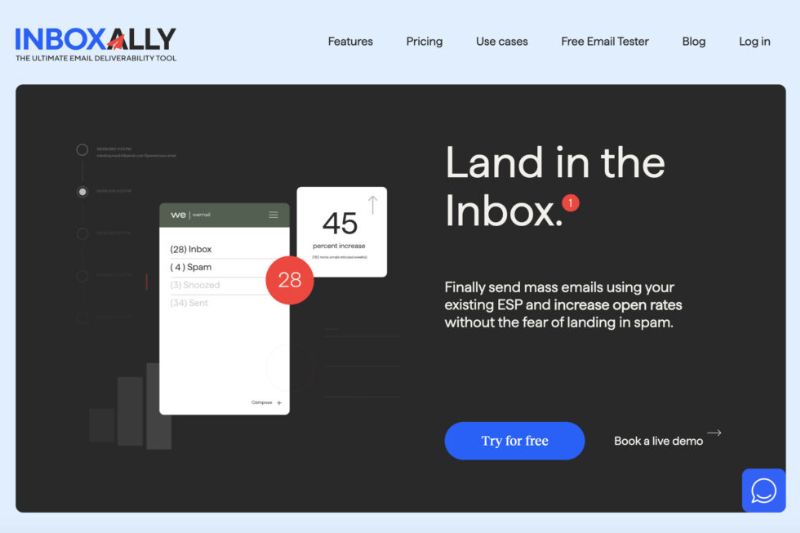O marketing por e-mail geralmente envolve uma rede complexa de elementos como servidores, sistemas de nomes de domínio e endereços IP, todos conhecidos como infraestrutura de e-mail. O departamento de TI é o principal responsável por gerenciá-la, e entender esse sistema é vital para as equipes de marketing, pois oferece informações valiosas sobre o sucesso da campanha.
Para os gerentes de marketing e proprietários de empresas, entender os detalhes da infraestrutura de e-mail é a chave para campanhas bem-sucedidas, e não se trata apenas de enviar e-mails. É um processo cuidadoso que garante a segurança e a entrega na caixa de entrada.
Neste artigo, simplificaremos as complexidades da infraestrutura de e-mail, explorando seus componentes e funcionalidades para aumentar a eficácia de suas campanhas. Você quer melhorar a capacidade de entrega de seus e-mails? Experimente o InboxAlly! (mais sobre essa ferramenta abaixo)
Fique conosco enquanto entramos em detalhes e considere a possibilidade de conferir nossa ferramenta de entregabilidade de e-mail recomendada para que você tenha uma experiência de e-mail tranquila e segura.
![]()
O que é infraestrutura de e-mail?
A estrutura de e-mail refere-se à estrutura subjacente e ao conjunto de tecnologias que permitem o envio, o recebimento e o gerenciamento de mensagens de e-mail. Inclui vários componentes de software e hardware e protocolos que trabalham juntos para facilitar a troca de mensagens eletrônicas pela Internet.
Muitas empresas criam uma infraestrutura de e-mail personalizada para aumentar a eficiência da comunicação. Essa prática ajuda a melhorar a experiência do cliente, permitindo que você envie e responda rapidamente aos e-mails dos clientes.
Por que isso é importante?
A infraestrutura de e-mail é indispensável por vários motivos que contribuem coletivamente para o bom funcionamento e o sucesso das empresas.
Um sistema de e-mail bem estabelecido mostra interações confiáveis e eficientes fora e dentro de uma organização. Muitas operações comerciais importantes dependem de uma comunicação eficaz por e-mail, desde consultas de clientes até colaboração interna.
A importância da infraestrutura de e-mail torna-se particularmente pronunciada nas interações com os clientes, onde as empresas podem responder prontamente a consultas, oferecer suporte e fornecer atualizações essenciais, promovendo uma experiência positiva para o cliente.
Além disso, uma infraestrutura de e-mail gerenciada profissionalmente com um domínio personalizado aumenta a credibilidade e o profissionalismo nas organizações, ou seja, entre os parceiros e as partes interessadas.
A função da infraestrutura de e-mail se estende à facilitação da transmissão de documentos e informações importantes, contribuindo para práticas robustas de documentação e manutenção de registros.
As empresas também utilizam o e-mail para colaboração e coordenação, contando com uma infraestrutura confiável para garantir o trabalho em equipe e o gerenciamento de projetos sem problemas. O alcance global do e-mail permite a comunicação instantânea além das fronteiras geográficas, possibilitando que a organização se conecte com um público internacional diversificado.
Além disso, uma infraestrutura de e-mail bem projetada incorpora medidas de segurança para proteger contra ameaças cibernéticas, como phishing e malware, garantindo a confidencialidade e a integridade das informações confidenciais.
Por fim, uma infraestrutura de e-mail robusta facilita a adesão aos padrões de conformidade regulamentar relacionados à proteção e à privacidade dos dados.
Tipos de infraestrutura de e-mail
1. Código aberto
A infraestrutura de e-mail de código aberto oferece uma plataforma econômica para que as empresas personalizem o código e as funcionalidades de acordo com seus requisitos específicos.
Apesar de serem gratuitas, essas plataformas geralmente precisam de ajuda com problemas como o fluxo de e-mails indesejados e mensagens de spam. A vantagem está na criação de várias contas de e-mail e no envio de mensagens ilimitadas sem taxas de assinatura, o que permite uma rápida escalabilidade sem restrições orçamentárias.
As empresas podem controlar os limites de usuários e outros parâmetros e aprimorar os recursos de segurança e integração. Entretanto, a utilização de soluções de código aberto exige conhecimento técnico e gerenciamento interno.
2. Serviço MTA baseado em nuvem
Um agente de transferência de correio (MTA) baseado na nuvem e hospedado por um fornecedor terceirizado na nuvem oferece um início conveniente sem a necessidade de investimentos em hardware físico.
Os principais benefícios incluem fácil escalabilidade à medida que os negócios crescem, economia com a eliminação dos custos iniciais de hardware, alta disponibilidade devido à infraestrutura robusta da nuvem e gerenciamento simplificado.
Com uma infraestrutura de e-mail hospedada, o provedor de serviços cuida da manutenção do hardware, das atualizações de software e das medidas de segurança, permitindo que as empresas se concentrem nas atividades principais sem se aprofundar em detalhes técnicos.
3. Licenciado comercialmente
Um agente de transferência de correio no local, licenciado comercialmente, tem tudo a ver com confiabilidade e controle total. As equipes de marketing podem personalizar as configurações de envio e integrar-se perfeitamente aos sistemas de back-end.
Essa solução oferece opções abrangentes de gerenciamento e ajuste para todos os aspectos do e-mail, desde a marcação de diferentes tipos de rejeição até a configuração de taxas de envio de caixas de correio e ISPs individualmente. As soluções locais oferecem uma visão geral holística dos processos por meio de uma integração profunda com dados locais, fornecendo insights valiosos específicos para as necessidades da organização.
4. Envio de nuvem híbrida
A infraestrutura de e-mail híbrida combina a força das soluções baseadas na nuvem e no local, oferecendo adaptabilidade para atender a requisitos específicos. Essa abordagem permite flexibilidade na escolha de quais componentes você deve hospedar na nuvem e quais deve manter no local.
Os benefícios incluem flexibilidade e escalabilidade de impostos, permitindo que as empresas dimensionem aspectos específicos do sistema de e-mail com base nas necessidades em evolução.
Além disso, oferece controle de dados e conformidade, permitindo a manutenção de dados confidenciais no local e aproveitando a escalabilidade e a confiabilidade da nuvem para outros aspectos.
Esse modelo híbrido também otimiza os custos, utilizando a relação custo-benefício da nuvem para determinados serviços e, ao mesmo tempo, mantendo no local os componentes sensíveis ou com uso intensivo de recursos.
Elementos críticos da infraestrutura de e-mail
Endereços IP
Há dois tipos de endereços IP: Endereço IP compartilhado e endereço IP dedicado.
Endereço IP compartilhado:
O IPS compartilhado funciona como um espaço de trabalho conjunto com vários usuários compartilhando o mesmo IP, o que o torna econômico, pois a taxa de hospedagem é compartilhada.
No entanto, a entrega de e-mails pode ser afetada por outras pessoas no servidor compartilhado, o que pode levar à colocação na pasta de spam. Os IPs compartilhados são adequados para remetentes de baixo volume que não enviam regularmente um grande número de e-mails.
Endereço IP dedicado:
Um IP dedicado é exclusivo para você e oferece controle sobre sua reputação de envio. Embora minimize o risco de você ser afetado por outras pessoas, ele tem um custo mais alto.
Para otimizar um IP dedicado, as empresas devem enviar um volume significativo de e-mails (pelo menos 100 mil por mês) para manter uma reputação positiva de e-mail. Ele oferece melhor controle sobre o gerenciamento da reputação e resolução mais rápida de problemas.
Qual deles você deve escolher?
A decisão depende do tamanho da empresa e do volume de e-mails. Remetentes de alto volume que buscam controle total sobre a reputação do IP devem escolher um IP dedicado. Os remetentes de baixo volume ou aqueles que estão estabelecendo sua reputação de envio podem se beneficiar de IPs compartilhados.
Relacionado: IP compartilhado vs. IP dedicado – Qual é o melhor?
Servidor de correio eletrônico
A comunicação por e-mail depende de servidores essenciais, e entender suas funções é vital. O servidor de saída, o servidor SMTP, vê as mensagens do Mail User Agent e autentica o endereço de e-mail dos destinatários por meio de registros DNS. Se você falhar nas verificações, poderá receber e-mails devolvidos ou ser colocado em uma lista negra por baixa reputação de e-mail.
Após a autenticação bem-sucedida, os e-mails são enviados por meio de agentes de correio para o servidor de entrada do destinatário, que pode ser IMAP ou POP3, dependendo da configuração.
O IMAP armazena as mensagens recebidas nos servidores e as baixa quando o destinatário as recupera, permitindo o acesso e o gerenciamento centralizados no servidor, uma opção preferida por muitos clientes de e-mail.
Por outro lado, o POP3 também armazena mensagens em servidores, mas as exclui quando o destinatário recupera seus e-mails. Esse método depende menos de uma conexão com a Internet, pois as mensagens são baixadas simultaneamente, permitindo o acesso off-line.
Esses servidores formam coletivamente a espinha dorsal da infraestrutura de e-mail, garantindo a troca segura e eficiente de mensagens eletrônicas.
Agentes de correio
Agente de usuário de correio (MUA)
Os MUAs são aplicativos clientes de e-mail usados pelos usuários finais para compor, enviar, receber e gerenciar mensagens de e-mail. Os exemplos incluem o Outlook, o Thunderbird e clientes baseados na Web, como o Gmail.
Agente de envio de correspondência (MSA)
Os agentes de envio de e-mail atuam como intermediários entre o agente de usuário de e-mail (MUA) e o agente de transferência de e-mail (MTA). Ele recebe a mensagem do cliente de e-mail, examina-a em busca de erros e, se estiver tudo certo, encaminha-a para o MTA.
Agente de transferência de correio (MTA)
Os MTAs são softwares responsáveis pelo roteamento e transferência de mensagens de e-mail entre servidores de e-mail. Eles usam o SMTP para enviar e-mails e se comunicar com outros MTAs para garantir a entrega adequada.
Agente de entrega de mensagens (MDA)
Depois que o e-mail é recebido pelo Mail Transfer Agent e processado pelo agente de envio de e-mail, o agente de entrega de mensagens assume o controle, colocando o e-mail na caixa de correio apropriada no servidor de correio de entrada do destinatário.
O MDA executa várias tarefas, incluindo o gerenciamento da entrega de e-mails à caixa de correio do usuário correto, a aplicação de regras de filtragem ou classificação especificadas pelo usuário e a organização das mensagens na caixa de correio.
Ele cuida da etapa final do processo de entrega de e-mail, garantindo que o e-mail chegue ao público-alvo e seja armazenado adequadamente para acesso.
Loop de feedback
Um loop de feedback em estruturas de e-mail é projetado para melhorar a compreensão do remetente sobre como os destinatários interagem com seus e-mails.
Ele funciona como um canal de comunicação entre os provedores de serviços de Internet e os remetentes de e-mail, fornecendo informações valiosas sobre o envolvimento do usuário e permitindo que os remetentes tomem medidas corretivas.
Quando um destinatário marca um e-mail como spam ou indesejado, a FBL envia esse feedback para os remetentes. Essas informações são cruciais para identificar possíveis problemas, como conteúdo irrelevante, alta frequência ou e-mails indesejados, permitindo que eles ajustem suas práticas de e-mail e mantenham uma reputação positiva de remetente.
Uma reputação positiva do remetente garante que os e-mails legítimos cheguem às caixas de entrada dos destinatários em vez de serem marcados como spam.
O Feedback Loop serve como uma ferramenta para que os remetentes de e-mail aumentem a capacidade de entrega de seus e-mails, reduzam a probabilidade de serem marcados como spam e melhorem a qualidade geral de suas campanhas de e-mail.
Ele promove práticas de e-mail responsáveis e centradas no cliente, fomentando um ecossistema de e-mail melhor para remetentes e destinatários.
Relacionado: Entregabilidade de e-mail – Tudo o que você precisa saber para evitar a pasta de spam
Ferramentas de gerenciamento de reputação
As equipes de marketing integram inteligência de negócios e ferramentas analíticas em sua infraestrutura para se conectar de forma mais eficaz com seus públicos de e-mail. Essas ferramentas desempenham um papel fundamental no monitoramento de conversões, nas taxas de abertura e na automação do gerenciamento de campanhas, inspirando confiança no desempenho da campanha.
Para atingir essas metas, os profissionais de marketing geralmente utilizam ferramentas de gerenciamento de reputação de e-mail que se concentram em tarefas como segmentação de listas de e-mail, acompanhamento de taxas de abertura e envolvimento, monitoramento da entrega de e-mail e avaliação da reputação de IP e domínio.
Essas ferramentas empregam análise e inteligência de negócios para medir e monitorar a reputação do remetente do e-mail. Elas rastreiam meticulosamente a capacidade de entrega de e-mails, as reclamações de spam e as taxas de rejeição.
Além disso, eles fornecem insights sobre métricas essenciais de e-mail, incluindo taxas de abertura, taxas de cliques e taxas de conversão.
Reconhecendo a importância crítica do gerenciamento de reputação na comunicação por e-mail, essas ferramentas se tornam indispensáveis para evitar listas negras e garantir o sucesso de seus esforços de divulgação por e-mail.
Por que escolher o InboxAlly?
Garantir que suas mensagens cheguem à caixa de entrada do destinatário é fundamental para o sucesso. O InboxAlly surge como um poderoso aliado para os profissionais de marketing por e-mail, projetado exclusivamente para evitar que os e-mails cheguem às pastas de spam.
Essa ferramenta vai além dos provedores de serviços de e-mail convencionais, oferecendo uma abordagem especializada que aumenta drasticamente as taxas de abertura e afeta positivamente seus resultados. Um recurso de destaque do InboxAlly é sua capacidade de instruir os provedores de e-mail sobre a priorização de suas mensagens para o posicionamento na caixa de entrada. Ao compreender as dificuldades do domínio do remetente e das caixas de entrada do destinatário, o InboxAlly ensina os provedores de e-mail a reconhecer e priorizar seus e-mails.
Essa abordagem estratégica melhora significativamente as taxas de abertura, garantindo que suas mensagens recebam a atenção que merecem. Isso beneficia especialmente os usuários que desejam estabelecer e manter uma reputação positiva de remetente.
Normalmente, os clientes experimentam uma mudança notável, escapando da pasta de spam e testemunhando suas taxas de abertura mais do que dobrarem em um curto período de 4 a 14 dias.
Resumo
Então é isso: tudo o que você precisa saber sobre infraestrutura de e-mail!
Lembre-se de que entender a infraestrutura de e-mail ajuda você a ter sucesso a longo prazo. Isso ajuda você a tomar decisões informadas, evitar riscos à reputação, proteger seu e-mail de ser colocado na lista negra e tomar as medidas certas para melhorar a capacidade de entrega e a experiência do cliente.
Você quer levar seu alcance de e-mail para o próximo nível? Use o InboxAlly agora!



